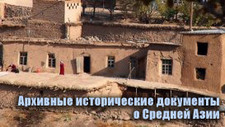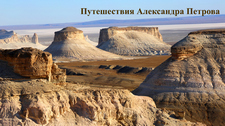Вы здесь
Kyzyl-Asker West Glacier.
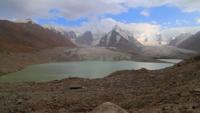
Tours to glaciers of northern slope of Kakshaal-Too Range.
"And now, looking at the glacier's glow under the stars, remember: its heart has become ice, and its breath – eternal cold. As long as the Kyzyl-Asker Glacier lives, so too does the memory of the heart that once dared to love more than the mountains. And perhaps, when the ice melts one day, its heart will beat again somewhere beneath the Aksu winds."
Glaciers in Eastern Aksai River Valley.
Kyzyl-Asker West Valley Glacier No. 80 is located within Kyzyl-Asker Mountain Range, on northern slope of western Kakshaal-Too Range in upper reaches of Western Kyzyl-Asker River in Atbashi District of Naryn Region.
The Kyzyl-Asker West Valley Glacier descends the steep northern slope of the Kakshaal-Too Range into the upper reaches of the East Aksu Valley, where the river of the same name originates. It belongs to the basin of the largest Central Asian river, the Tarim River, which now flows through the People's Republic of China.
Kyzyl-Asker West Glacier No. 80 is 9.2 kilometers long, covers an area of 12.23 square kilometers, has a perimeter of 21.66 kilometers, and reaches a maximum width of 2.7 kilometers in the central part. The glacier lies in a deep valley formed by ancient glacial and fluvioglacial processes. Its tongue extends for several kilometers down the gorge, and its feeder is hidden in vast firn fields and snow saddles, connected by a chain of cirques beneath the peaks of the Kyzyl-Asker Ice Massif.
Unlike the Eastern Kyzyl-Asker Glacier, the western one is more compact, but has thicker ice and a thick snow accumulation belt. The glacier is primarily fed by snow and firn. In winter, precipitation brought by westerly winds penetrates here, and in spring and early summer, numerous streams rush down the slopes, feeding the lower layers of ice.
The total area of the glacier varies from season to season, but its role in maintaining the flow of the Eastern Aksu River remains key: it is here that the first, purest streams of glacial water originate. The surrounding terrain is composed of crystalline rocks – gneisses, granites, and crystalline schists.
Traces of ancient glacial activity can be found on the valley's surface: smoothed cliffs, moraine ridges, and outcrops with characteristic glacial grooves. Old moraines, evidence of previous ice advances during colder eras, are clearly visible in the lower part of the glacier.
In summer, the glacier's surface is covered with alternating light and dark bands of moraine material. In the sun, they create the impression of a living mosaic, constantly changing hue depending on the time of day. The rumble of subglacial streams can be heard from cracks - the waters emerge at the foot of the glacier, giving rise to cold streams that feed the East Aksu River.
Despite the harsh climate, patches of alpine vegetation, mountain grasses, wormwood, and Kuril tea grow around the glacier. Eagles nest on the rocky ledges, and argali, snow grouse, and snowcocks inhabit the moraine zones. Current observations indicate that the Kyzyl-Asker West Glacier, like many glaciers in the Kakshaal-Too Range, is gradually shrinking.
The lower part of the tongue is actively degrading, exposing a rocky bed where temporary lakes and seeps are forming. Scientists have noted accelerated melting in recent decades, which is associated with regional warming and a decrease in solid precipitation.
Hydrological Significance of Kyzyl-Asker West Glacier
Kyzyl-Asker West Glacier plays a vital role in shaping the runoff of the Eastern Aksu-Tarim system, one of the largest hydrological systems in Central Asia. Meltwater originating in the glacier's crevasses and channels flows into the narrow channel of the Kyzyl-Asker West River, which, joining with the eastern branch, forms the Eastern Aksu River.
The waters then flow westward, passing through a series of gorges and foothill valleys, where they form a steady flow that feeds the desert's largest river, the Tarim River. Thus, the Western Kyzyl-Asker Glacier is one of the high-altitude "water towers" of Central Asia.
It supplies fresh water to vast, dry areas located hundreds of kilometers downstream. In years with low precipitation, this glacier feeder becomes the main source of water for the valley ecosystems of the Tarim Basin. Studying the dynamics and mass of this glacier allows scientists to predict changes in the region's water resources under conditions of global warming.
Even a slight reduction in area The glacier's decline could lead to reduced summer runoff, which is especially important for the transboundary rivers feeding Xinjiang's oases. The aesthetics and symbolism of the icy world of the northern slope of the Kakshaal-Too Ridge.
From the passes in the Borkoldoy Ridge, the Western Kyzyl-Asker Glacier is visible as a vast silvery river frozen in time. Its surface is veined with cracks, resembling ancient writings in which one can read the history of the mountains. When the icy mass glows pink in the rays of dawn, it seems as if before you is the breath of the Earth itself, preserving the memory of its icy ages.
For geographers, climbers, and photographers, this place is more than just a dot on the map. The Western Kyzyl-Asker Glacier is one of those rare corners where nature preserves a pristine harmony of cold, light, and silence. He reminds us that ice is not only the keeper of water, but also the chronicle of the mountains, and the living heart of the highlands.
Legend of Western Kyzyl-Asker Glacier.
Once upon a time, in the lands where today lies the cold kingdom of ice and stone, lived the mountain Kyrgyz, who worshiped the winds and the peaks. Among them was a young man named Asker—a brave hunter, strong in spirit but soft in heart.
His yurt stood at the foot of the mountains, where clear springs gushed from cracks in the rocks. One day, a wanderer from distant lands descended into the valley. With him was a girl whose eyes were blue as spring ice, and whose voice resembled the babbling of a snowy stream.
She was promised to another, but fate decreed otherwise - love blossomed between her and Asker, pure as the mountain air and powerful as the wind on the pass. When the clan elders learned of this, they forbade them from meeting. The mountains are guardians of the law, and breaking it was punished not by men, but by nature itself.
But the young man ignored the warnings. He ascended to the peaks to ask the mountain spirits for permission to be with his beloved. At that moment, a hurricane blew over the valley, and snow swirled so thickly that no one saw Asker again. When the storm subsided, where he had stood, people found only an ice crack oozing cold steam.
Since then, they say:
"His heart turned to transparent ice, and his breath to eternal cold."
Thus was born the Kyzyl-Asker Western Glacier - the guardian of love that became eternity. They say that on quiet evenings, when the sun touches the peaks of Borkoldoy, a light mist rises above the glacier. This is Asker's breath, still searching for the voice of his beloved.
Shepherds passing through the East Aksu Valley sometimes hear a soft ringing sound, like the echo of a song. Elders say it's the ice singing - singing of a love that neither the mountains nor time could conquer.
Practical information for travelers and explorers visiting Kyzyl-Asker West Glacier.
The approaches to the Kyzyl-Asker West Glacier No. 80 lie in one of the most inaccessible parts of the Kakshaal-Too Range. The roads end long before the high-mountain valley, and the trail continues through a rocky, swampy valley where true mountain silence reigns.
This is where explorers, geographers, experienced climbers, and tourists come people accustomed to altitude, wind, and solitude. The best time for expeditions and observations is the short high-altitude summer: late July to early September. During this period, the snow cover on the slopes thins, opening up trails and roads along moraine ridges and valley beds.
However, even in summer, nights here are cold: temperatures can drop to -5°C, rising sharply to +15°C during the day. Sudden changes in weather are normal, so warm clothing, windproof jackets, mountaineering boots, or better yet, high rubber boots, and navigation equipment are essential.
Particular attention should be paid to acclimatization: the region's altitude exceeds 3,800 - 4,000 meters, and the climb requires time to acclimatize. It's important to keep in mind that the routes here pass through passes where snow remains until mid-summer.
The glacier is of exceptional interest for scientific and photographic expeditions: here, one can observe the melting dynamics, the structure of the moraines, the system of crevasses, and ice flows. But the place is no less valuable for those who seek inspiration in these mountains.
One can truly feel the breath of the planet, the primordial power of nature, timeless. A visit to the Kyzyl-Asker West Glacier leaves travelers with a rare sense of inner peace, as if the ice itself, preserving centuries, imparts a piece of its eternity.
A short parable-verse, heard from an old shepherd spending night at foot of Kyzyl-Asker West Glacier.
A warrior with a frosty breath sleeps among the rocks,
Guardian of the passes where the wind is harsh.
Ice is a memory untouched by time,
The heart of the mountain that preserves an old call.
Geographical coordinates of Kyzyl-Asker West Glacier No. 80: N41°04'07 E77°19'21
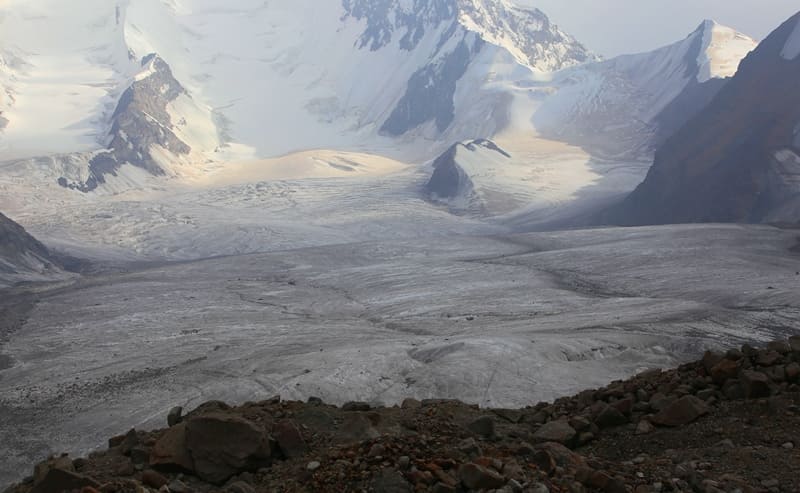
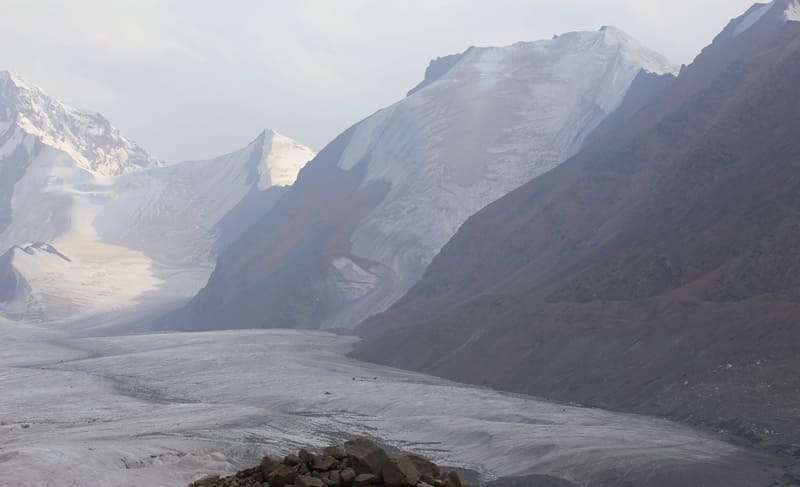
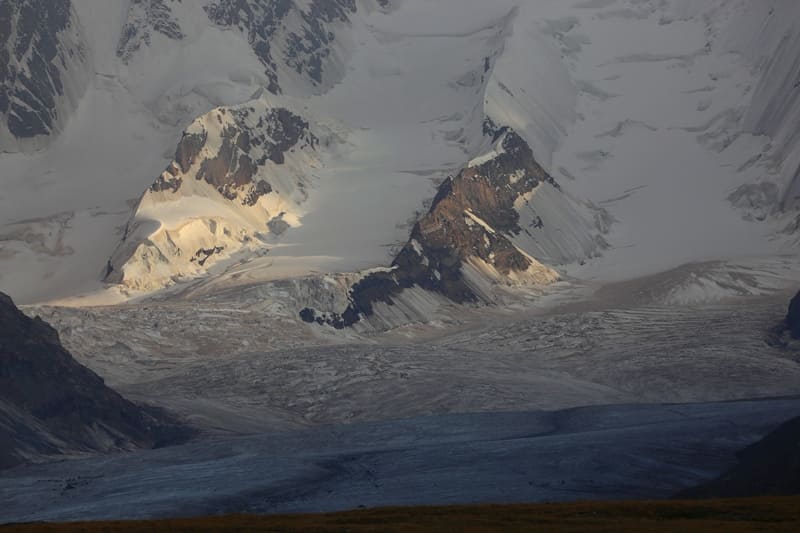
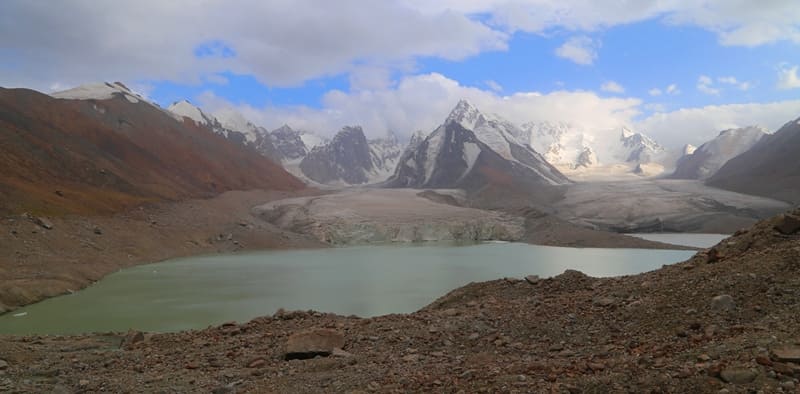
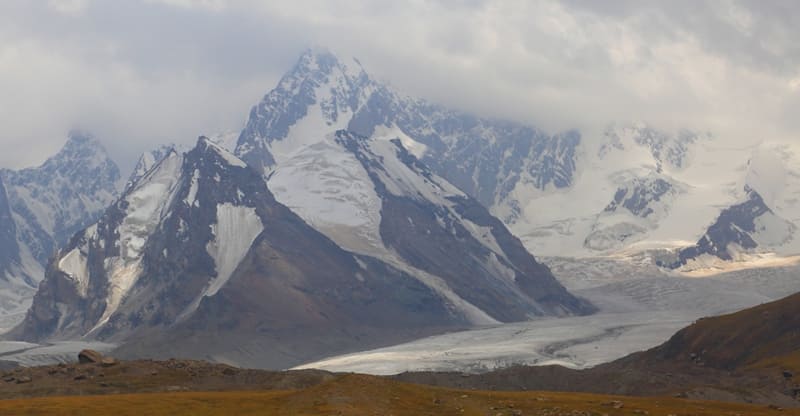
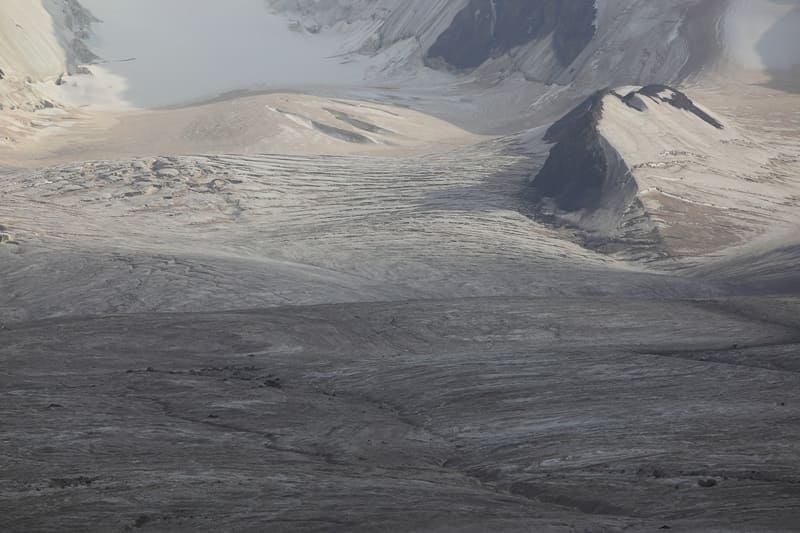
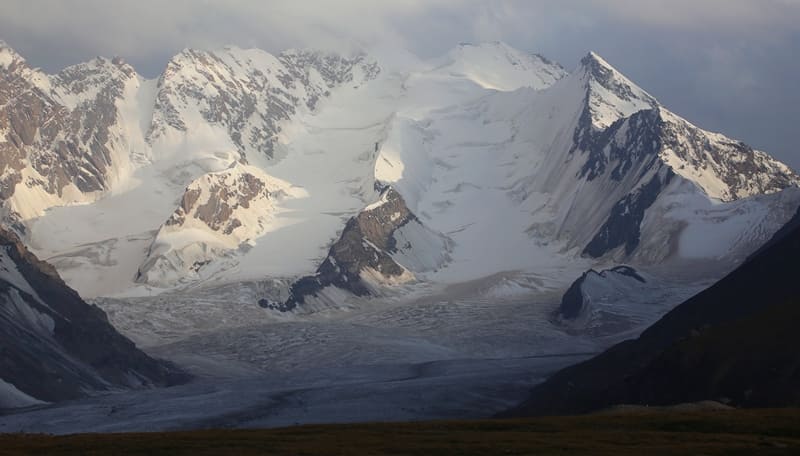
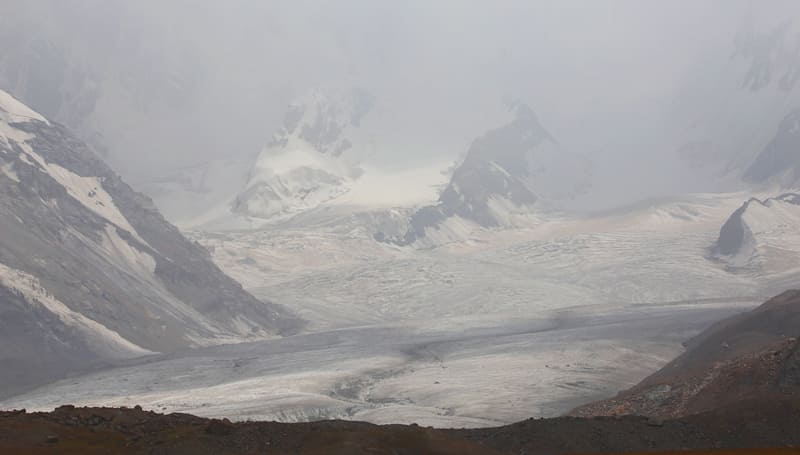
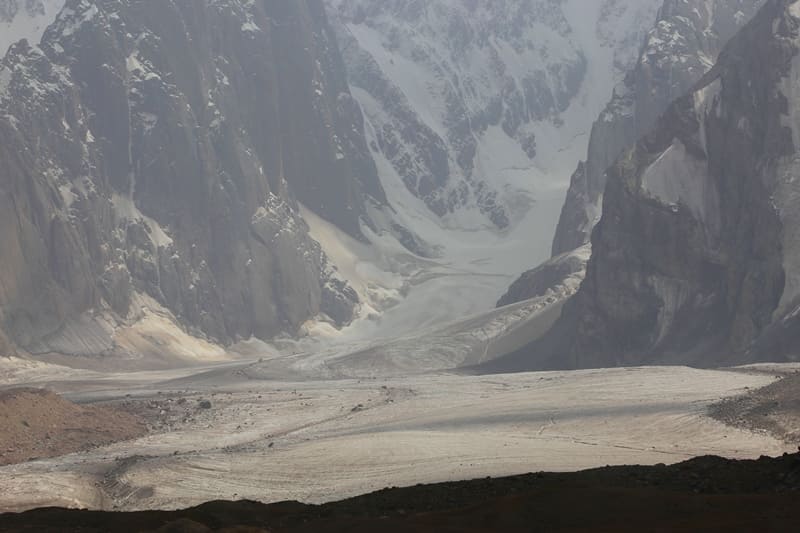
Authority and photos by:
Alexander Petrov.





